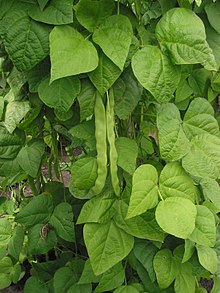Phaseolus vulgaris
| Phaseolus vulgaris | |
|---|---|
 |
|
|
A flat-podded variety of the common bean
|
|
| Scientific classification | |
| Kingdom: | Plantae |
| (unranked): | Angiosperms |
| (unranked): | Eudicots |
| (unranked): | Rosids |
| Order: | Fabales |
| Family: | Fabaceae |
| Subfamily: | Faboideae |
| Tribe: | Phaseoleae |
| Subtribe: | Phaseolinae |
| Genus: | Phaseolus |
| Species: | P. vulgaris |
| Binomial name | |
|
Phaseolus vulgaris L. |
|
| Synonyms | |
|
|
Phaseolus vulgaris, the common bean (also known as the string bean, field bean, flageolet bean, French bean, garden bean, green bean, haricot bean, pop bean, snap bean, or snap), is a herbaceous annual plant grown worldwide for its edible dry seed (known as just "beans") or unripe fruit (green beans). Raw or undercooked beans contain the toxin phytohaemagglutinin. Its leaf is also occasionally used as a vegetable and the straw as fodder. Its botanical classification, along with other Phaseolus species, is as a member of the legume family Fabaceae, most of whose members acquire the nitrogen they require through an association with rhizobia, a species of nitrogen-fixing bacteria.
The common bean is a highly variable species that has a long history of cultivation. All wild members of the species have a climbing habit, but many cultivars are classified as "bush beans" or "pole beans", depending on their style of growth. These include the kidney bean, the navy bean, the pinto bean, and the wax bean. The other major types of commercially grown bean are the runner bean (Phaseolus coccineus) and the broad bean (Vicia faba).
Beans are grown in every continent except Antarctica. Brazil and India are the largest producers of dry beans, while China produces, by far, the largest quantity of green beans. Worldwide, 23 million tonnes of dry common beans and 17.1 million tonnes of green beans were grown in 2010.
...
Wikipedia
